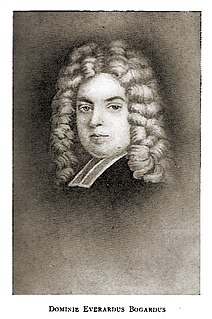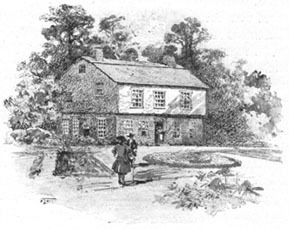Related Research Articles

New Amsterdam was a 17th-century Dutch settlement established at the southern tip of Manhattan Island that served as the seat of the colonial government in New Netherland. The initial trading factory gave rise to the settlement around Fort Amsterdam. The fort was situated on the strategic southern tip of the island of Manhattan and was meant to defend the fur trade operations of the Dutch West India Company in the North River. In 1624, it became a provincial extension of the Dutch Republic and was designated as the capital of the province in 1625.

Peter Stuyvesant was a Dutch colonial officer who served as the last Dutch director-general of the colony of New Netherland from 1647 until it was ceded provisionally to the English in 1664, after which it was split into New York and New Jersey with lesser territory becoming parts of other colonies, and later, states. He was a major figure in the early history of New York City and his name has been given to various landmarks and points of interest throughout the city.

New Netherland was a 17th-century colony of the Dutch Republic that was located on what is now the East Coast of the United States. The claimed territories extended from the Delmarva Peninsula to southwestern Cape Cod, while the more limited settled areas are now part of New York, New Jersey, Delaware, and Connecticut, with small outposts in Pennsylvania and Rhode Island.

Willem Kieft was a Dutch merchant and the Director of New Netherland from 1638 to 1647.
This is a list of Directors, appointed by the Dutch West India Company, of the 17th century Dutch province of New Netherland in North America. Only the last, Peter Stuyvesant, held the title of Director General. As the colony grew, citizens advisory boards – known as the Twelve Men, Eight Men, and Nine Men – exerted more influence on the director and thus affairs of province.
The Council of Twelve Men was a group of 12 men, chosen on 29 August 1641 by the residents of New Netherland to advise the Director of New Netherland, Willem Kieft, on relations with the Native Americans due to the murder of Claes Swits. Although the council was not permanent, it was the first representational form of democracy in the Dutch colony. The next two councils created were known as the Eight Men and the Nine Men.

The Peach Tree War, also known as the Peach War, was a large-scale attack on September 15, 1655 by the Susquehannock Indians and allied tribes on several New Netherland settlements along the North River.

Adriaen Cornelissen van der Donck was a lawyer and landowner in New Netherland after whose honorific Jonkheer the city of Yonkers, New York, is named. Although he was not, as sometimes claimed, the first lawyer in the Dutch colony, Van der Donck was a leader in the political life of New Amsterdam, and an activist for Dutch-style republican government in the Dutch West India Company-run trading post.
The council of Eight Men was an early representational democracy in New Netherland. It replaced the previous Twelve Men and was followed by the Nine Men.

Fort Casimir or Fort Trinity was a Dutch fort in the seventeenth-century colony of New Netherland. It was located on a no-longer existing barrier island at the end of Chestnut Street in what is now New Castle, Delaware.
Kieft's War (1643–1645), also known as the Wappinger War, was a conflict between the colony of New Netherland and the Wappinger and Lenape Indians in what is now New York and New Jersey. It is named for Director-General of New Netherland Willem Kieft, who had ordered an attack without approval of his advisory council and against the wishes of the colonists. Dutch colonists attacked Lenape camps and massacred the inhabitants, which encouraged unification among the regional Algonquian tribes against the Dutch and precipitated waves of attacks on both sides. This was one of the earliest conflicts between settlers and Indians in the region. The Dutch West India Company was displeased with Kieft and recalled him, but he died in a shipwreck while returning to the Netherlands; Peter Stuyvesant succeeded him in New Netherland. Numerous Dutch settlers returned to the Netherlands because of the continuing threat from the Algonquians, and growth slowed in the colony.

Pavonia was the first European settlement on the west bank of the North River that was part of the seventeenth-century province of New Netherland in what would become the present Hudson County, New Jersey.
Cornelis Melyn was an early Dutch settler in New Netherland and Patroon of Staten Island. He was the chairman of the council of eight men, which was a part of early steps toward representative democracy in the Dutch colony.
New Netherlanders were residents of New Netherland, the seventeenth-century colonial province of the Republic of the Seven United Netherlands on the northeastern coast of North America, centered on the Hudson River and New York Bay, and in the Delaware Valley.

Jan Evertsz Bout, was an early and prominent Dutch settler in the 17th century colonial province of New Netherland.

The Collegiate Reformed Protestant Dutch Church is a Dutch Reformed congregation in Manhattan, New York City, which has had a variety of church buildings and now exists in the form of four component bodies: the Marble, Middle, West End and Fort Washington Collegiate Church, all part of the Reformed Protestant Dutch Churches of New York. The original congregation was established in 1628.

The Reverend Everardus Bogardus was the dominie of the New Netherlands, and was the second minister of the Dutch Reformed Church, the oldest established church in present-day New York, which was then located on Pearl Street at its first location built in 1633, the year of his arrival. Bogardus was, in fact, the second clergyman in all of the New Netherlands.

Jochem Pietersen Kuyter was an early colonist to New Netherland, and one of the first settlers of what would become Harlem on the island of Manhattan. He became an influential member of the community and served on the citizen boards known as the Twelve Men, the Eight Men and the Nine Men.

Stuyvesant Farm, also known as the Great Bowery, was the estate of Peter Stuyvesant, the last Dutch director-general of the colony of New Netherland, as well as his predecessors and later his familial descendants. The land was at first designated Bowery No. 1, the largest and northernmost of six initial estates of the Dutch West India Company north of New Amsterdam, used as the official residence and economic support for Willem Verhulst and all subsequent directors of the colony.
References
- 1 2 3 Russell Shorto, The Island at the Center of the World: The Epic Story of Dutch Manhattan and the Forgotten Colony that Shaped America. First Edition. New York City: Vintage Books (a Division of Random House, 2004), p.179. ISBN 1-4000-7867-9
- ↑ Bennet, Tom (2019) "Dollar Ship of South Wales". ISBN 9781916157316
- ↑ Russell Shorto, The Island at the Center of the World: The Epic Story of Dutch Manhattan and the Forgotten Colony that Shaped America. First Edition. New York City: Vintage Books (a Division of Random House, 2004), p.191-192. ISBN 1-4000-7867-9
- ↑ Charles Hemstreet, "CHAPTER V: WILLIAM KIEFT and the WAR with the INDIANS" Chap. in The Story of Manhattan, (New York City: Charles Scribner's Sons, 1901), Released as The Project Gutenberg eBook, The Story of Manhattan, by Charles Hemstreet, E-text prepared by Gregory Smith, David Garcia, and the Project Gutenberg Online Distributed Proofreading Team